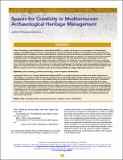Por favor, use este identificador para citar o enlazar a este item:
http://hdl.handle.net/10261/223337COMPARTIR / EXPORTAR:
 SHARE SHARE
 CORE
BASE CORE
BASE
|
|
| Visualizar otros formatos: MARC | Dublin Core | RDF | ORE | MODS | METS | DIDL | DATACITE | |

| Campo DC | Valor | Lengua/Idioma |
|---|---|---|
| dc.contributor.author | Almansa Sánchez, Jaime | es_ES |
| dc.date.accessioned | 2020-11-21T17:28:35Z | - |
| dc.date.available | 2020-11-21T17:28:35Z | - |
| dc.date.issued | 2020-07-17 | - |
| dc.identifier.citation | Advances in Archaeological Practice 8(3): 275-287 (2020) | es_ES |
| dc.identifier.uri | http://hdl.handle.net/10261/223337 | - |
| dc.description.abstract | [EN] Public Archaeology in the Mediterranean Context (#pubarchMED) is a project that focuses on the management of archaeological heritage in the Mediterranean context from the perspective of public archaeology. Ranging from fully public models where preventive archaeology itself is a challenge to mixed models where the outsourcing of this work has been accomplished to a full extent, the variety of solutions is wide and with a common trend: struggle with mitigation and little space for creativity. This article will delve into the range of models that exist in the Mediterranean, exploring the way they approach, first of all, preventive/rescue archaeology, and then, the relationship between archaeology and society in the process. Building on the challenges of an underfunded scheme for an extremely archaeologically rich territory, different solutions have been set in practice—in some cases, under the auspices of competent administrations in the form of public policy—in the endeavor to include public archaeology in the practice, mostly encouraged by professionals as a personal or corporate initiative, and sometimes even consciously avoided. The discussion will offer some ideas for creative mitigation in the different scenarios, built on the comparative study and the broad possibilities to engage stakeholders positively in the process. | es_ES |
| dc.description.abstract | [ES] Arqueología Pública en el Contexto Mediterráneo (#pubarchMED) es un proyecto enfocado al estudio de la gestión del patrimonioarqueológico en el contexto mediterráneo desde la perspectiva de la arqueología pública. Desde modelos puramente públicos en los quela arqueología preventiva es un reto, a otros modelos mixtos en los que la subcontratación de los servicios es ya total, la variedad desoluciones es amplia, siempre con una tendencia común: dificultades para mitigar y poco espacio para la creatividad. Este trabajoprofundizará en la variedad de modelos existentes en el Mediterráneo y cómo abordan, primero, la arqueología preventiva o de rescate y,después, la relación arqueología-sociedad en el proceso. Sobre los retos de un esquema malfinanciado en un territorio extremadamenterico en patrimonio arqueológico, se han puesto en práctica diferentes soluciones, en algunos casos bajo el auspicio de la administracióncompetente, en vías de incluir la arqueología pública en el proceso, pero en la práctica fomentado por la iniciativa privada de individuosu otras instituciones, o conscientemente evitado. La discusión ofrecerá algunas ideas para la mitigación creativa en los diferentes esce-narios, a través del estudio comparativo y las innumerables posibilidades de involucrar de forma positiva a los diferentes actores queforman parte del proceso. | - |
| dc.description.sponsorship | This project has been possible thanks to the postdoctoral contract offered by the Galician Innovation Agency (GAIN) from Xunta de Galicia. | - |
| dc.language.iso | eng | es_ES |
| dc.publisher | Cambridge University Press | - |
| dc.relation.isversionof | Publisher's version | es_ES |
| dc.rights | openAccess | es_ES |
| dc.subject | #pubarchMED | es_ES |
| dc.subject | Public archaeology | - |
| dc.subject | Preventive archaeology | - |
| dc.subject | Creative mitigation | - |
| dc.subject | Mediterranean | - |
| dc.subject | Arqueología pública | - |
| dc.subject | Arqueología preventiva | - |
| dc.subject | Mitigación creativa | - |
| dc.subject | Mediterráneo | - |
| dc.title | Spaces for Creativity in Mediterranean Archaeological Heritage Management | es_ES |
| dc.type | artículo | es_ES |
| dc.identifier.doi | 10.1017/aap.2020.21 | - |
| dc.description.peerreviewed | Peer reviewed | es_ES |
| dc.relation.publisherversion | https://doi.org/10.1017/aap.2020.21 | es_ES |
| dc.identifier.e-issn | 2326-3768 | - |
| dc.rights.license | https://creativecommons.org/licenses/by/4.0/ | es_ES |
| dc.rights.license | http://creativecommons.org/licenses/by/4.0/ | - |
| dc.contributor.funder | Axencia Galega de Innovación | - |
| dc.relation.csic | Sí | es_ES |
| oprm.item.hasRevision | no ko 0 false | * |
| dc.identifier.funder | http://dx.doi.org/10.13039/501100010769 | es_ES |
| dc.contributor.orcid | Almansa Sánchez, Jaime [0000-0002-8690-200X] | es_ES |
| dc.type.coar | http://purl.org/coar/resource_type/c_6501 | es_ES |
| item.languageiso639-1 | en | - |
| item.fulltext | With Fulltext | - |
| item.openairecristype | http://purl.org/coar/resource_type/c_18cf | - |
| item.cerifentitytype | Publications | - |
| item.grantfulltext | open | - |
| item.openairetype | artículo | - |
| Aparece en las colecciones: | (INCIPIT) Artículos | |
Ficheros en este ítem:
| Fichero | Descripción | Tamaño | Formato | |
|---|---|---|---|---|
| Almansa2020_AAP.pdf | Versión del editor | 1,97 MB | Adobe PDF |  Visualizar/Abrir |
CORE Recommender
SCOPUSTM
Citations
3
checked on 18-abr-2024
WEB OF SCIENCETM
Citations
2
checked on 26-feb-2024
Page view(s)
171
checked on 23-abr-2024
Download(s)
206
checked on 23-abr-2024
Google ScholarTM
Check
Altmetric
Altmetric
Este item está licenciado bajo una Licencia Creative Commons

